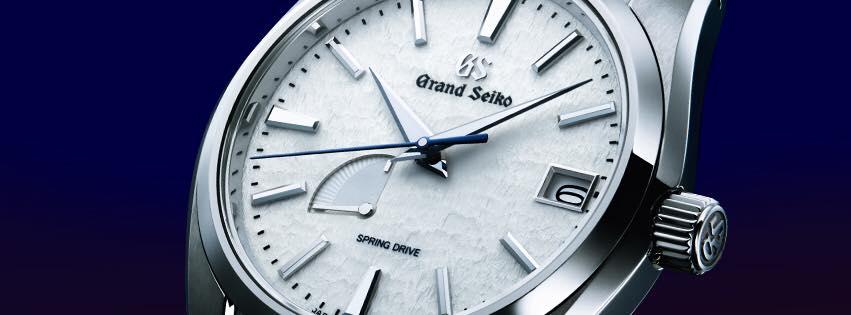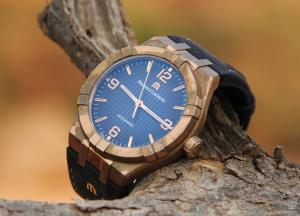The Grand Seiko Snowflake: A Comprehensive Review

The Grand Seiko Snowflake is one of those watches that you have to look at carefully to truly appreciate. Indeed, observing the full beauty of this iconic watch takes time as it has a lot of subtle tricks up its sleeve. And like a snowflake, it only gets better the more time you spend observing the little patterns on it.
While it bears the most iconic design that Grand Seiko has, this watch offers more than just aesthetics. Inside, it houses a piece of technology that will leave every watch enthusiast drooling. And due to its uniqueness, it often sparks debates on whether it is considered a mechanical or quartz watch. We’ll learn the answer to this question in a while.
Yes, it is named after a delicate crystal of snow, but it has an avalanche of features. Read on to find out what surprises this watch has in store for us.
The Snowflake Dial
One of the defining characteristics of the watch is its dial. From afar, people might brush it off as a normal white dial with nothing special in it. But don’t let it fool you. You would be missing out on a lot if you fail to take a closer look.
Staying true to its winter motif, the Snowflake’s dial mimics the texture of freshly fallen snow. But for the sake of people who live in non-snowing places, it can also be compared to textured white paint. To our knowledge, only Grand Seiko has achieved this kind of texture thus far.
It also exhibits a minimalistic style. Despite having two complications, namely the power reserve indicator and date window, the dial remains clean and simple.
Indeed, Grand Seiko takes their designs seriously. So, let’s take a look at how they made the dial.

How Grand Seiko Makes the Snowflake Dial
As you might have guessed, the dial of the Grand Seiko Snowflake goes through a lot of stages. In fact, it is made with care by experts at the Shiojiri dial workshop. As for the first step, the manufacturers stamp the pattern onto a dial blank. After that, they add multiple layers of coating. This is what causes the translucency of the final dial.
Beautiful at Every angle
Meanwhile, the hour markers are cut using diamond-edged rotary cutting equipment. This is manually done by a technician who sees to it that the surface of the indexes reflects the light in a good way. Generally, this is done with a small mirror. Lastly, when the indexes pass rigorous testing, each of them is applied onto the dial by hand.
It may look like a small thing but this is exactly the reason why enthusiasts take pleasure in observing the watch as the light hits it from different angles.
Handled with Care
As seen above, the production of each Grand Seiko dial is labour-intensive. The amount of work that goes into each small detail is immense. And it is arguably one of the reasons that set Grand Seiko apart from the others.
Due to the amount of attention that the technicians have to give each watch, Grand Seiko can only produce models in a relatively small number (approximately 35,000 units per year). This can be viewed as good news if you value exclusivity or if you’re a firm believer that quality trumps quantity.

Case and Bracelet
The case of the Grand Seiko Snowflake uses what Grand Seiko calls “High Intensity” titanium. Compared to normal titanium, this one is more resistant to corrosion and scratches. Additionally, it shares the lightness and hypoallergenic characteristics of the metal. Those who are allergic to nickel would find this piece of information relieving.
In terms of dimensions, the case measures 41mm in diameter and 12.5mm in height. This size falls in the middle range and people will generally find this watch a good fit.
Just like the case, the bracelet of the Grand Seiko Snowflake is made of titanium. This makes the watch more comfortable as the material is relatively light.
The Spring Drive Movement
The inside of the Grand Seiko Snowflake is just as impressive as its exterior. If there’s one other thing that defines the watch other than its Snowflake dial, it is the Spring Drive movement.
There’s a lot of history behind the brand’s popular calibre. The project was conceived by Yoshikazu Akahane, who was an engineer at Seiko Epson. In the late 1970s, he started developing the movement. Eventually, he was able to issue a patent for the concept in 1982.
Despite being issued a patent, it was only in 1997 when the company publicly launched the movement at Baselworld. And the year after, they released the first commercially-available Spring Drive watches.

Is it quartz or Mechanical?
One of the common mistakes that people commit is calling the Grand Seiko Snowflake a quartz watch. Yes, the Spring Drive movement exhibits a few quartz-like characteristics. However, if you dig deeper, you’ll notice that it is far from a quartz movement.
If truth be told, the only similarity it has with a quartz movement is the use of a quartz oscillator. Other than that, the two movements are polar opposites of each other. Firstly, quartz requires a battery while the Spring Drive does not. Also, the Spring Drive is powered by mainsprings that do not appear in quartz watches.
What’s so Special about the Spring Drive?
Now, we’ve settled the issue about the Spring Drive being a mechanical movement. However, it is important to note that it is a unique type.
For one, you won’t see the escape wheel, lever, and balance inside it. Instead, it uses the Tri-Synchro Regulator. As its name suggests, it refers to the three types of energy in the regulating system. These are magnetic (glide wheel), mechanical (mainspring), and electrical (quartz crystal).
This system generates a current which then goes to a quartz crystal and an integrated circuit. As the current goes through it, it produces vibrations that are counted as oscillations. In the end, energy is fed back and makes the glide wheel turn 8 times per second. This is very similar to how a normal mechanical watch works.
To put it another way, the Grand Seiko Snowflake’s source of power is the traditional mainspring. It only differs in how they regulate that energy. And this is why the Spring Drive is considered a mechanical watch.
Accuracy of the Spring Drive
This technology from the Japanese brand is what makes the Grand Seiko Snowflake extremely accurate. In fact, it has been adopted by the renowned Swiss brand Piaget. You might also encounter gossips that other major watch brands have shown interest in it.
Speaking of its accuracy, sources say that it has a rating of +/- 1 second per day on average. Indeed, this is a highly desirable number that a lot of watchmakers dream of achieving.
Grand Seiko Snowflake Special Editions
No doubt, the Snowflake is a marvel in terms of watch design. However, the folks over at Grand Seiko love spicing up things every now and then. With that said, here are three Grand Seiko Snowflakes with a twist. But in spite of the slight variations, it’s impressive how these models still exhibit the must-haves in the brand’s style bible.
1. Taisetsu (Winter)
The Taisetsu is part of the Four Seasons collection of Grand Seiko. As its name suggests, it consists of four models that are based on each of the seasons. Two of those seasons are based on the Grand Seiko Snowflake. One is the Taisetsu (Winter) and the other is Shunbun (Spring).
At first glance, especially in low-light conditions, this looks indistinguishable from the original Grand Seiko Snowflake. In fact, their designs are both inspired by the same thing — snow. However, after spending a few minutes comparing the two models, you’ll notice the subtle differences.
For one, the Taisetsu has a darker dial while the original model has a snow-white hue that represents the calmness of winter. This one comes in light grey to remind you of cloudy skies during a blizzard.
Another unique thing about this edition is its bezel or lack of it. This means that the crystal had to be attached directly to the case thus enhancing legibility. Additionally, its lugs have also been redesigned to make the watch more comfortable to wear.
2. Shunbun (Spring)
Once all the snow has gone, it’s time for Spring. And as mentioned above, this model is part of the Four Seasons collection. In fact, along with the winter edition, this one was assembled at the Shinshu Watch Studio.
Its dial is light pink in colour with a soft texture. In fact, it is so light that it is only visible at certain angles. In some light conditions, the dial gives off an off-white hue. This represents the blooming of Japan’s famous cherry blossoms.
Save for its colour, the Shunbun is identical to the winter edition of the collection. It has the same proportions and case. Additionally, it also uses the Spring Drive 9R65 calibre movement.
The Shunbun is Grand Seiko’s first widely-available watch in a pink dial. Because of that, it enticed watch enthusiasts all over the globe, making it relatively hard to acquire.

3. Blue Snowflake
The Grand Seiko Blue Snowflake owns the title of the first-ever special edition of the original Snowflake. And as its name suggests, it has a distinguished soft blue dial that stands out while remaining clean.
Unlike the original model that uses titanium, this one uses stainless steel for the case. This material gives the watch a heftier feel. But to make up for the added weight, this version is slightly smaller. From the original 41mm size, this one is down to 40.8mm.
Another subtle change is the hour markers at the 6, 9, and 12 o’clock position. Instead of the usual trapezoids, it uses thick rectangles that look a lot like the other markers.

4. Golden Snowflake
The Grand Seiko Golden Snowflake is arguably the most elegant of the bunch. Its hands and hour markers come in brilliant gold hue. Although nothing much is added to the watch, the choice of colour gives off a warm vibe. This is in contrast to the calm and cool colour scheme of the original variant.
Aside from the new colour, nothing is changed. It bears the same dimensions, material, and movement of the Grand Seiko Snowflake.
Final Notes
The Grand Seiko Snowflake excels both in looks and performance. When it comes to aesthetics, it follows the elements of the Grand Seiko Style that reflects the Japanese sense of beauty.
On the other hand, the watch uses a one-of-a-kind innovation called the Spring Drive. It combines the best qualities of the quartz and mechanical movements. It is indeed a testament to Japan’s excellence in technology.
Learn more about Japanese watches by going through our article on the Orient Bambino!


